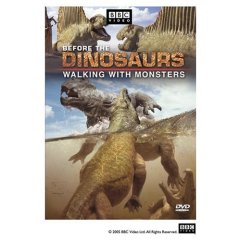
Walking with Monsters is the first series in the Walking with... saga. It has been distributed as Before the Dinosaurs - Walking with Monsters, and Walking with Monsters - Life Before Dinosaurs. It is a three part documentary series focusing on life before the dinosaurs, from around 542 million years ago, to 250 million years ago. Like Walking With Dinosaurs, it is directed by Tim Haines.
Episode 1[]
Episode 1 examines the Cambrian Period, exploring a life dominated by invertebrates such as Anomalocaris, and the rise of vertebrates. Later it moves on to the Silurian, where invertebrate sea scorpions still rule but fish like Cephalaspis are outsmarting them. Then we go to the Devonian Period, when tetrapods have arrived on the land and predatory fish are following them.
Episode 2[]
Episode 2 looks at the Carboniferous Period, where reptiles are trying to survive in a perilous world dominated by giant amphibians, giant centipedes and mesothelae solifugids. After a hyper oxygen fuelled lightning-induced forest fire we travel to the early Permian. When reptiles have been given the opportunity to take over and grow into more massive forms, due to the decline of the forest and swamp world into a drier and more arid world.
Episode 3[]
Focuses on the Late Permian Period and Early Triassic Period. In the former half of the episode, the plight of the Pangaean Therapsids (mammal like reptiles) and Pareiasaur Anapsids (the Scutosaurus) is looked at, explaining how the mass extinction is destroying ecosystems everywhere. The rains fail, and the inhabitats of the area around the water hole in Siberia are desperately clinging onto an ever evaporating water source. Scutosaurus arrive and drink it dry, forcing a resident Labyrinthodont Amphibian, Rhinesuchus, to form a cacoon around itself to survive (but not before we see it try to attack and kill a fully grown female Gorgonopsid in sheer desperation) Little Diictodon, 'Gophers of the Permian', outlast the chaos by finding refuge underground.
They are erroneously shown to give rise to the Lystrosaurs, though this can be interpretted as not being a transition of evolution down a single line, as with all 'steps forward in time' (the morphing sequences). The latter half of the episode looks at the vast mega herds of Lystrosaurus that make up half of all animal life on Earth during the Early Triassic, 248 Million Years Ago; the setting being Antarctica. Never again will a single species do so well - thanks to their exploitation of the void left by the mass extinction that wiped out 98% of all life. Theracephalians, Archosaurs (the Chasmatosaurs, specifically of the species Proterosuchus) and the enigmatic Euparkeria are shown in this latter half also. Euparkeria is said to be the direct ancestor of the Dinosaurs.
Though not scientifically correct in a most accurate sense - Euparkeria IS NOT the direct ancestor to the Dinosaurs, but is a close relative of something else that was, but ultimately this is not such a difference between Euparkeria and the as yet unknown exact missing link species that was (liking something like Ornithosuchus)
After a dramatic river crossing by a herd of Lystrosaurus searching for fresh grazing, which is intercepted by the ravenous Chasmatosaurs Proterosuchus, Euparkeria is seen to morph into (for convenience of course to demonstrate the narrators words) into a true Dinosaur; eventually walking off as an Allosaurus into the Late Jurassic setting familiar to us in Time of the Titans and The Ballad of Big Al. The series ends where Walking With Dinosaurs began - the Age of the Dinosaurs dawns.